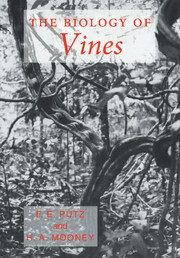Book contents
- Frontmatter
- Contents
- List of contributors
- Foreword
- Preface
- Acknowledgements
- I INTRODUCTION
- II CLIMBING MECHANICS AND STEM FORM
- III VINE PHYSIOLOGY AND DEVELOPMENT
- 5 Water flux and xylem structure in vines
- 6 Reserve economy of vines
- 7 Photosynthesis and gas exchange of vines
- 8 Heteroblastic development in vines
- 9 Physiological ecology of mesic, temperate woody vines
- 10 Secondary compounds in vines with an emphasis on those with defensive functions
- IV COMMUNITY ECOLOGY OF VINES
- V ECONOMIC IMPORTANCE OF VINES
- Taxonomic index
- General index
8 - Heteroblastic development in vines
Published online by Cambridge University Press: 05 November 2011
- Frontmatter
- Contents
- List of contributors
- Foreword
- Preface
- Acknowledgements
- I INTRODUCTION
- II CLIMBING MECHANICS AND STEM FORM
- III VINE PHYSIOLOGY AND DEVELOPMENT
- 5 Water flux and xylem structure in vines
- 6 Reserve economy of vines
- 7 Photosynthesis and gas exchange of vines
- 8 Heteroblastic development in vines
- 9 Physiological ecology of mesic, temperate woody vines
- 10 Secondary compounds in vines with an emphasis on those with defensive functions
- IV COMMUNITY ECOLOGY OF VINES
- V ECONOMIC IMPORTANCE OF VINES
- Taxonomic index
- General index
Summary
Introduction
All plants pass through a series of developmental changes from seedling to reproductive age. In many plants the shifts in development are subtle, involving internode distance or small changes in leaf size and shape. In others the changes are profound, so much so that early and late stages have been identified as separate species. Goebel (1900) recognized these differences in the degree of developmental change, designating the former as homoblastic and the latter as heteroblastic. Since Goebel's treatment, the concept of heteroblastic development has been extended to species in which the juvenile to adult transition is more gradual, which includes the majority of plants (Allsopp, 1965), and the term has been applied to developmental changes in floral form in the reproductive phase (Lord, 1979).
The following traits can change during heteroblastic development: (i) leaf size and shape; (ii) leaf anatomy; (iii) phyllotaxis; (iv) internode length; (v) stem thickness; (vi) shoot apex structure and zonation; (vii) tropic response; (viii) regenerative capacity; (ix) physiology; (x) reproductive status (Goebel, 1900; Troll, 1937, 1939; Allsopp, 1965, 1967; Doorenbos, 1965; Richards, 1983). The change from juvenile to adult character states can occur at different times for each of these characters, e.g. changes in leaf shape can occur before changes in reproductive status. This temporal variability indicates that the concept of heteroblasty probably includes a number of indirectly related developmental changes (Allsopp, 1965; Borchert, 1976).
- Type
- Chapter
- Information
- The Biology of Vines , pp. 205 - 244Publisher: Cambridge University PressPrint publication year: 1992
- 7
- Cited by



